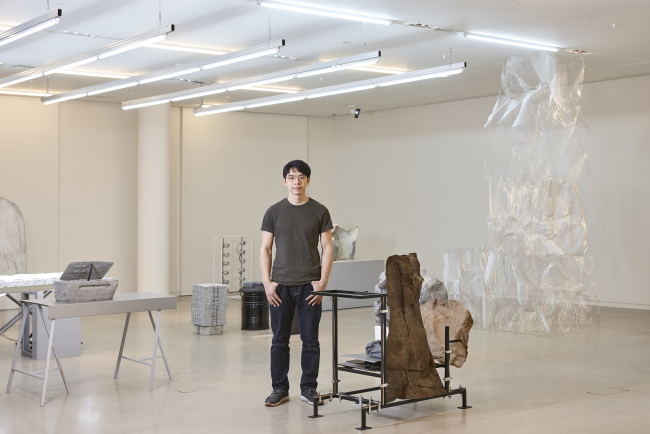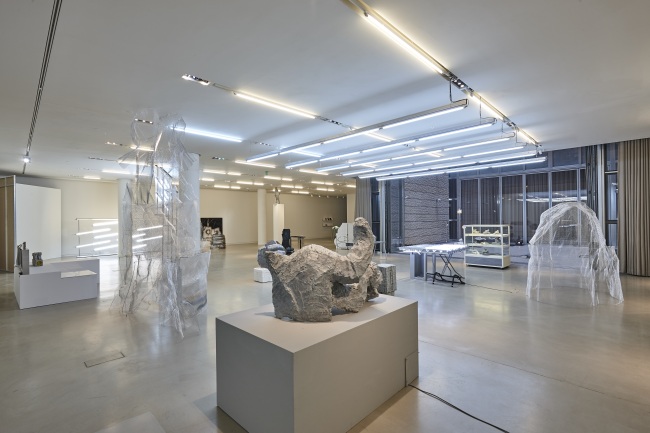‘Lack of aesthetic sensibility could pose threat to others’
Jung Ji-hyun comments on public art in ‘Multipurpose Henry’
By Shim Woo-hyunPublished : April 1, 2019 - 17:41
Scattered throughout the gallery space are collages of various materials and found objects. Some are shown on classical sculpture podiums, others on metal frames or plastic foam. A sculpture in a corner periodically releases white vapor, like the water vapor and toxic gases that spew in a volcanic eruption.
These make up artist Jung Ji-hyun’s solo exhibition at Atelier Hermes in Maison Hermes Dosan Park in Seoul.
Born in 1986, Jung is an artist who works primarily with the byproducts and waste of the urban landscape, deconstructing and reconstructing them.
These make up artist Jung Ji-hyun’s solo exhibition at Atelier Hermes in Maison Hermes Dosan Park in Seoul.
Born in 1986, Jung is an artist who works primarily with the byproducts and waste of the urban landscape, deconstructing and reconstructing them.

“Multipurpose Henry” is Jung’s commentary on public art installations found in cities. By reinterpreting sculptures in the public space, Jung tackles the nation’s public art practices -- particularly those that result from the national cultural policy that mandates the installation of works of art in public spaces and large-scale public art projects led by local governments.
The title “Multipurpose Henry” is Jung’s sarcastic response to such practices.
“In public spaces, there are many replicas of famous sculptures. There are many of Henry Moore, for instance. They look like works by Moore, but you can instantly notice that they are replicas of well-known masterpieces because they lack certain sculptural qualities,” Jung said.
Jung criticized the bureaucratic and insensitive approaches to public art.
“Installations of public artworks or projects need to be done through thorough communication with citizens who actually use the spaces. But they are often executed very hurriedly. Regardless of their good intentions, the outcomes often turn out to be something less than what they could have been,” Jung said. “The installation of the gigantic statue of King Sejong at Gwanghwamun Square also seemed to me to be one of the cases in which the artwork doesn’t ‘get along’ with the location.”
Jung’s encounter with a bronze statue of Donghak Peasant Revolution leader Jeon Bong-jun -- installed in April last year in front of the Youngpoong Bookstore in Jongno, Seoul -- prompted the works on show at Atelier Hermes.
“I was talking with my friends one day, and I came across the statue in front of the bookstore and next to the boulevard. I found it funny. At the same time I was puzzled by how suddenly the figurative sculpture came into being in the urbanscape,” Jung said.
That led him to observe public sculptures more carefully, and he started to play with that idea. He made castings of sculptures he had observed and reassembled them into something of his own.

Sitting in the middle of the gallery is Jung’s 2018 work “Filing Public Parts,” a result of the artist‘s interaction with a Fernando Botero-style statue installed outside a building in Seoul. The sculpture, a collage of metal mesh pieces, was shown at Art Sonje in 2018.
A series of questions led him to think about our own aesthetic sensibility: “Are those statues in urban spaces, like peasant revolution leader Jeon, the results of our aesthetic insensibility?”
A lack of aesthetic taste could “pose a threat” to others, Jung said, referring to how art could create a feeling of dissonance in viewers.
“There are many locations in this city where artworks are installed not for the sake of art but for the sake of meeting the law, and sometimes looking at them is a very unsettling experience.”
Jung argued that perhaps we need to pay more attention to aesthetics when putting works of art in public spaces.
“Our aesthetic taste is very closely related to how we think. Maybe we have become accustomed to overstimulation, which has dulled our aesthetic senses. That may be why we overlook details and don’t see them,” Jung said.
Jung intentionally made the exhibition appear disorderly to encourage viewers to ask questions.
“I could have just laid out stories or meanings related to the sculptures, but I have intentionally made the exhibition look ambiguous and disoriented. Ambiguity here is the starting point for new thoughts,” Jung said.
Jung has made slight alterations to existing objects he found in public spaces -- changes that are so minute that one has to pay attention to recognize the differences.
“People sometimes ask me if they are really sculptures. Some also say that they don’t know if I am a sculptor,” Jung said. “I think the same questions can be asked of public art. Are you really public art?”
The exhibition runs through May 5.
By Shim Woo-hyun (ws@heraldcorp.com)
-
Articles by Shim Woo-hyun



![[Exclusive] Korean military set to ban iPhones over 'security' concerns](http://res.heraldm.com/phpwas/restmb_idxmake.php?idx=644&simg=/content/image/2024/04/23/20240423050599_0.jpg&u=20240423183955)




![[Herald Interview] 'Amid aging population, Korea to invite more young professionals from overseas'](http://res.heraldm.com/phpwas/restmb_idxmake.php?idx=644&simg=/content/image/2024/04/24/20240424050844_0.jpg&u=20240424200058)

![[Pressure points] Leggings in public: Fashion statement or social faux pas?](http://res.heraldm.com/phpwas/restmb_idxmake.php?idx=644&simg=/content/image/2024/04/23/20240423050669_0.jpg&u=)









